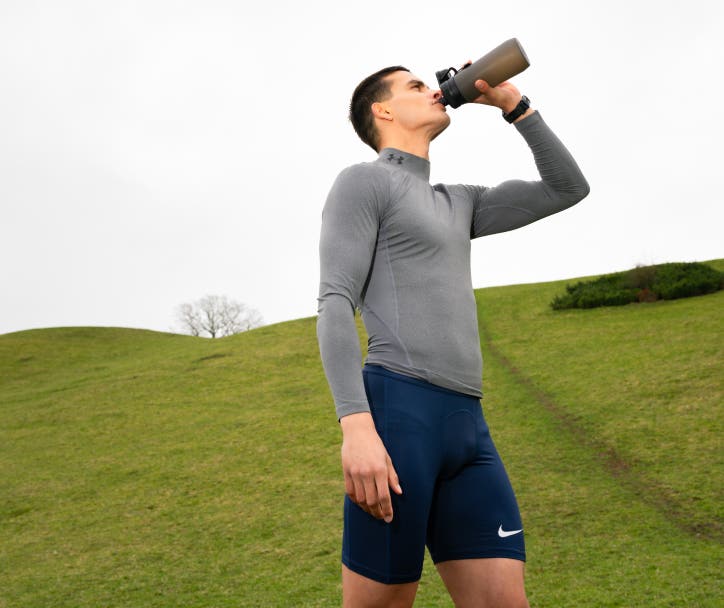Sweating is one of your body's most fascinating and essential functions.
And while it can be annoying to have sweat dripping down your face during an intense God workout, those salty droplets are pretty important. Sweating is a crucial mechanism for regulating body temperature and maintaining overall health.
What is sweat?
Sweat consists mainly of water, acting as the primary solvent for electrolytes and other dissolved substances. In addition to water, sweat contains electrolytes, like sodium, potassium, and chloride. In the body, electrolytes play an important role in maintaining fluid balance, regulating muscle function, and facilitating nerve transmission within the body.
Sodium is the most abundant electrolyte in sweat and is responsible for maintaining fluid balance and osmotic pressure. Potassium helps regulate muscle contractions, including the heart. While chloride, often found as sodium chloride (table salt), contributes to maintaining proper hydration levels and electrolyte balance.
Why do we sweat?
Sweating is a complex physiological process essential for maintaining homeostasis within your body. Its main functions include temperature regulation and stress response.
Temperature regulation
Your body thrives in a narrow range of temperatures that are ideal for your peak physiological performance. As external temperatures rise or internal heat production spikes during physical activity, the body triggers a series of mechanisms to prevent overheating. And one of those mechanisms is sweating.1
Sweat glands, which cover the skin's surface, function to remove excess heat from the body. These glands are connected to the sympathetic nervous system, which responds to signals from the hypothalamus, a region of the brain responsible for regulating body temperature. When the hypothalamus detects an increase in your core body temperature, it sends signals to the sweat glands to get to work.
Sweat is secreted onto the skin's surface through ducts connected to the sweat glands. As sweat evaporates from the skin, it absorbs heat energy from the body, cooling the skin and lowering core body temperature. This evaporative cooling process is remarkably efficient, enabling your body to uphold thermal stability even in challenging environmental conditions.
Stress response
Have you ever felt sweat seeping through your shirt and your armpits dampening during an important interview or high-stakes presentation? That's your body's fight-or-flight response kicking in.
It's true – sweating can also be triggered by emotional or psychological stress, in addition to temperature regulation. This phenomenon, known as emotional sweating, involves a distinct set of neural pathways and hormonal signals separate from those involved in temperature regulation.
Under stress, the sympathetic branch of the autonomic nervous system kicks into gear, triggering the notorious fight-or-flight response.
During fight-or-flight, your body prepares to confront or evade perceived threats by mobilizing resources and heightening awareness. This includes increasing heart rate, dilating airways, and activating sweat glands to dissipate excess heat generated by heightened metabolic activity. As a result, you may experience sweating, no matter the temperature around you.
Emotional sweating may involve the release of stress hormones like cortisol and adrenaline, which alter your body's response to stress. These hormones can impact sweat gland activity and sensitivity, intensifying sweating in response to emotional arousal.

Sweat’s impact on athletic performance
Sweating plays a critical role in helping your body adapt to physical exertion and environmental conditions. As you train hard and push your limits, your body becomes more efficient at regulating temperature and managing sweat production as a result of different physiological adaptations. All that to push you even further.
Heat acclimatization is one such adaptation, which occurs as your body gradually adjusts to exercising in hot environments. Through repeated exposure to heat stress, you can experience improvements in sweat rate, electrolyte balance, and cardiovascular function, all of which contribute to enhanced performance in hot conditions.2
Factors influencing sweat production
Several factors contribute to sweat production, including genetics, fitness level, and environmental factors.
Environmental factors such as temperature, humidity, and altitude can also influence sweat production by affecting the body's heat dissipation mechanisms.3 For example, in hot and humid conditions, the body may produce more sweat to compensate for reduced evaporative cooling, whereas, at higher altitudes, decreased air pressure can lead to faster evaporation and increased sweat loss.
While genetic predispositions and environmental factors contribute to individual differences in sweat production, certain lifestyle factors, such as hydration status and dietary choices, can also impact sweat volume and composition.
Managing water and mineral loss
To maintain hydration, electrolyte balance, and overall performance during exercise, it is important to effectively manage water and mineral loss from sweat. That means prioritizing hydration before, during, and after physical activity. Whether you opt for electrolytes, a sports drink, or good old-fashioned H2O, replacing those lost fluids and minerals is essential.
During extended or intense workouts, especially in hot environments, consider consuming sports drinks or electrolyte supplements to replenish lost sodium, potassium, and other electrolytes. Adding salt-rich foods to post-exercise meals can also help restore electrolyte levels and support recovery.
Debunking myths about sweat
Despite its importance, people can get a little salty (pun intended) about sweat. Let’s debunk the most common misconceptions and myths:
- Sweating means you are out of shape: Sweating is a natural physiological response to heat and physical exertion, not an indication of fitness level.
- The more you sweat, the more you get rid of toxins: While sweat does contain trace amounts of metabolic waste products, the primary function of sweating is temperature regulation, not detoxification.
- The more you sweat, the more weight you lose: Sweating leads to temporary water loss, not fat loss. Any weight lost through sweat will be quickly regained upon rehydration.
- Sweating is a sign of an effective workout: While sweating during exercise is normal, it's not necessarily indicative of the workout's effectiveness. Focus on other progress markers, such as strength gains and endurance improvements.
- Electrolytes and sports drinks are always good for you: Sports drinks are usually loaded with sugar and electrolytes. These can be great during physical exertion or when needing to replenish after a tough workout or game. This doesn’t mean you should drink them while eating chips and playing video games.

Key takeaways:
- Essential function: Sweating is more than just a physical inconvenience. It is an important physiological function that regulates body temperature and maintains overall health. It acts as the body's primary cooling mechanism, allowing it to adapt to various environmental conditions and physical exertion.
- Composition of sweat: Sweat is primarily composed of water, along with essential electrolytes such as sodium, potassium, and chloride. These electrolytes help to maintain fluid balance, regulate muscle function, and support nerve transmission within the body.
- Dual purpose: Sweating serves two main purposes: temperature regulation and stress response. While its primary function is to dissipate excess heat generated by physical activity or external factors, sweating can also be triggered by emotional or psychological stress, reflecting the intricate interplay between the mind and body.
- Impact on athletic performance: Sweating is important for improving athletic performance by helping the body adapt to physical exertion and environmental conditions. Through mechanisms like heat acclimatization, athletes can enhance their sweat rate, electrolyte balance, and cardiovascular function, thereby improving their performance, particularly in hot environments.
- Management strategies: Effective management of water and mineral loss from sweat is needed for maintaining hydration, electrolyte balance, and overall performance during exercise. Hydration strategies should include consuming water or electrolyte-rich fluids before, during, and after physical activity, with additional consideration given to salt-rich foods and electrolyte supplements, particularly in hot conditions.
Remember, sweating is a natural and essential function of your body. Embrace it as a symbol of your body's incredible adaptability and resilience.
Sources
[1] Havenith, G. (2001). The interaction of clothing and thermoregulation. Research in Sports Medicine, 9(4), 205–228.
[2] Kenny, G. P., Jay, O., & Flouris, A. D. (2016). Thermometry, calorimetry, and mean body temperature during heat stress. Comprehensive Physiology, 6(4), 1705–1750.
[3] Taylor, N. A., & Machado-Moreira, C. A. (2013). Regional variations in transepidermal water loss, eccrine sweat gland density, sweat secretion rates and electrolyte composition in resting and exercising humans. Extreme Physiology & Medicine, 2(1), 4.